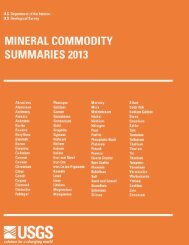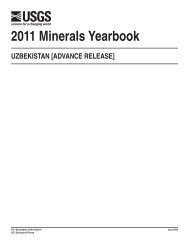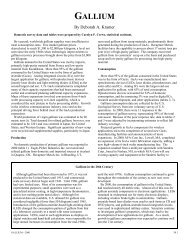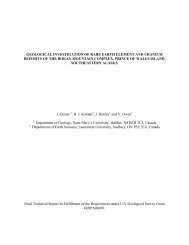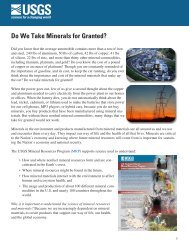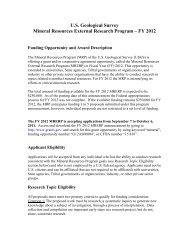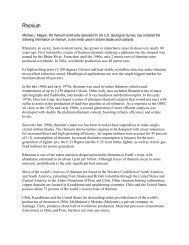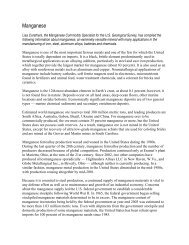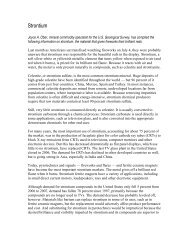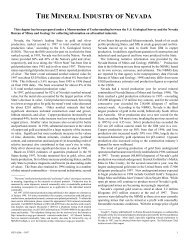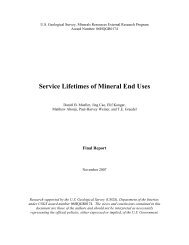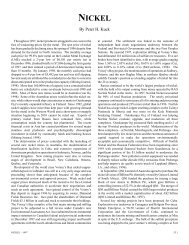Mineral Commodity Summaries 2003 - Mineral Resources Program ...
Mineral Commodity Summaries 2003 - Mineral Resources Program ...
Mineral Commodity Summaries 2003 - Mineral Resources Program ...
Create successful ePaper yourself
Turn your PDF publications into a flip-book with our unique Google optimized e-Paper software.
POTASH<br />
Early in 2002, the largest Canadian potash firm reported the completion of startup for a smaller iodine and potassium<br />
nitrate producer in Chile. In March of 2002, the sole domestic potassium nitrate producer idled its plant and filed for<br />
Chapter 11 bankruptcy protection as a subsidiary of a company that filed for Chapter 11 bankruptcy protection in New<br />
York Federal Courts. In August, the sole domestic potassium nitrate producer reportedly was shutting down. A<br />
Spanish fertilizer manufacturer announced the permanent shutdown of its 96-year-old sulfate of potash plant in<br />
Cartagena at about the same time.<br />
Based on data from the first half of 2002, estimated potash consumption in Africa, the Middle East, and Oceania<br />
increased by about 10% and may have accounted for about 5% of world consumption in 2002. On the same basis,<br />
potash consumption in Asia may have accounted for about 29% of the world total and declined by about 9%. Potash<br />
consumption in Central Europe, Eastern Europe, and Central Asia may have accounted for about 8% of the world total<br />
and declined by about 6%. Potash consumption in Latin America may have account for about 17% of the world total<br />
and increased by about 8%, while potash consumption in North America may have accounted for about 23% of the<br />
world total and declined by less than 4%. Western European potash consumption may have accounted for about 18%<br />
of the world total and declined by more than 9%.<br />
World Mine Production, Reserves, and Reserve Base: The production estimate for China has been significantly<br />
increased based on new information from that country. Reserves estimates for China also have been revised based<br />
on new information.<br />
Mine production Reserves 6<br />
Reserve base 6<br />
2001 2002 e<br />
United States<br />
1<br />
1,200<br />
1<br />
1,200 90,000 300,000<br />
Azerbaijan<br />
e<br />
5 5 NA NA<br />
Belarus 3,700 4,000 750,000 1,000,000<br />
Brazil 352 370 300,000 600,000<br />
Canada 8,200 8,760 4,400,000 9,700,000<br />
Chile 390 390 10,000 50,000<br />
China 385 420 8,000 450,000<br />
France 300 150 500 NA<br />
Germany 3,550 3,350 710,000 850,000<br />
Israel 1,774 1,930<br />
7<br />
40,000<br />
7<br />
580,000<br />
Jordan 1,178 1,200<br />
7<br />
40,000<br />
7<br />
580,000<br />
Russia 4,300 4,340 1,800,000 2,200,000<br />
Spain 525 510 20,000 35,000<br />
Ukraine 25 30 25,000 30,000<br />
United Kingdom 500 500 22,000 30,000<br />
Other countries — — 50,000 140,000<br />
World total (may be rounded) 26,400 27,000 8,300,000 17,000,000<br />
World <strong>Resources</strong>: Estimated domestic potash resources total about 6 billion tons. Most of this lies at depths<br />
between 1,830 and 3,050 meters in a 3,110-square-kilometer area of Montana and North Dakota as an extension of<br />
the Williston Basin deposits in Saskatchewan, Canada. The Paradox Basin in Utah contains approximately 2 billion<br />
tons, mostly at depths of more than 1,220 meters. A large potash resource lies about 2,130 meters under central<br />
Michigan. The U.S. reserves figure above contains approximately 62 million tons of reserves in central Michigan.<br />
Estimated world resources total about 250 billion tons. The potash deposits in the former Soviet Union and Thailand<br />
contain large amounts of carnallite; it is not clear if this can be mined in a free market, competitive economy.<br />
Substitutes: There are no substitutes for potassium as an essential plant nutrient and an essential nutritional<br />
requirement for animals and humans. Manure and glauconite are low-potassium-content sources that can be<br />
profitably transported only short distances to the crop fields.<br />
e<br />
Estimated. NA Not available. –– Zero.<br />
1<br />
Rounded to the nearest 0.1 million ton to protect proprietary data.<br />
2<br />
Rounded to the nearest 0.2 million ton to protect proprietary data.<br />
3<br />
Average prices based on actual sales; excludes soluble and chemical muriates.<br />
4<br />
Defined as imports - exports + adjustments for Government and industry stock changes.<br />
5<br />
Rounded to one significant digit to protect proprietary data.<br />
6<br />
See Appendix C for definitions.<br />
7<br />
Total reserves and reserve base in the Dead Sea are arbitrarily divided equally between Israel and Jordan for inclusion in this tabulation.<br />
129<br />
U.S. Geological Survey, <strong>Mineral</strong> <strong>Commodity</strong> <strong>Summaries</strong>, January <strong>2003</strong>



